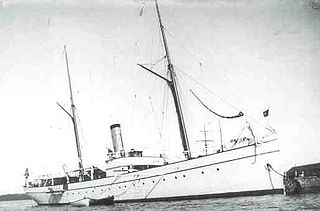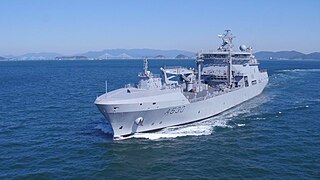This page is based on this
Wikipedia article Text is available under the
CC BY-SA 4.0 license; additional terms may apply.
Images, videos and audio are available under their respective licenses.

Haakon VII, known as Prince Carl of Denmark until 1905, was a Danish prince who became the first king of Norway after the 1905 dissolution of the union with Sweden. He reigned from November 1905 until his death in September 1957.

The Royal Norwegian Navy is the branch of the Norwegian Armed Forces responsible for naval operations of the state of Norway. As of 2008, the RNoN consists of approximately 3,700 personnel and 70 vessels, including 5 heavy frigates, 6 submarines, 14 patrol boats, 4 minesweepers, 4 minehunters, 1 mine detection vessel, 4 support vessels and 2 training vessels. The navy also includes the Coast Guard.

HNoMS Otto Sverdrup is a Fridtjof Nansen-class frigate of the Royal Norwegian Navy.
HMS P41 was a Royal Navy U-class submarine built by Vickers-Armstrong. She was transferred to the exiled Royal Norwegian Navy before completion and renamed HNoMS Uredd. She and one of the B-class in 1940 have so far been the only Norwegian submarine to have been sunk.

|}
The Taube was first constructed in 1909-1910 by Austrian Igo Etrich and later developed into a two-seater military aircraft in 1912. Many Taubes were built under licence by a wide array of manufacturers but most were produced by the Rumpler Flugzeugwerke. By 1912 the design had evolved to a 2-seater reconnaissance aircraft for military use
Built by Rumpler as a 2-seat Taube floatplane, Start was the Royal Norwegian Navy's very first aeroplane, bought in Germany and arriving in Horten on 25 May 1912, at a cost of 30,000 Norwegian kroner. Funding came from private contributions after a speedy initiative from the commander and officers of the submarine HNoMS Kobben, Norway's first submarine; one of the largest contributors was H.M. King Haakon VII of Norway.
The first flight was made on 1 June 1912 by SecondløytnantHans Fleischer Dons. He took off from Gannestad in Borre, flew over Karljohansvern naval station and Moss before landing in Øra, not far from Fredrikstad. The flight was 48 km long and took 35 minutes. Dons was congratulated by both the King and the government.
Start was officially given as a gift to the navy on 1 August 1912 and is today displayed at the Norwegian Armed Forces Aircraft Collection.

HNoMY Norge is the Royal Yacht of the King of Norway. One of only three remaining Royal Yachts in Europe, the ship's name Norge is Norwegian Bokmål for Norway. The Royal Yacht Norge was the Norwegian people's gift to King Haakon VII in 1947. The yacht is owned by the King but maintained and manned by the Royal Norwegian Navy. Originally built in 1937 in the United Kingdom for Thomas Sopwith, she served in the Royal Navy as an armed yacht during the Second World War.

The Royal Norwegian Navy Museum is a museum documenting the history of the Royal Norwegian Navy. It is located at the former main naval base of Karljohansvern in Horten. The museum was founded by C.F. Klinck on 24 August 1853. The museum is sometimes regarded as the world's first naval museum, as it was the first collection of naval memorabilia open to the public.
Several ships of the Royal Norwegian Navy have been named Æger, after Ægir – the Jötunn king of the sea in Norse mythology:
The "Look to Norway" speech by U.S. President Franklin D. Roosevelt was given during the handover ceremony of the Royal Norwegian Navy ship HNoMS King Haakon VII at the Washington Navy Yard on 16 September 1942. The speech served as an important source of inspiration to Norwegians fighting the German occupation of Norway and the rest of Europe as well as for the resistance fighters of other small countries during World War II.

HNoMS Heimdal was a Norwegian warship built at Akers mekaniske verksted in Kristiania, Norway in 1892 with build number 137.
HNoMS Utstein is a series of three submarines operated by the Royal Norwegian Navy. They were named after this historic Utstein Abbey which is located on the island of Klosterøy in Rennesøy, Norway. The three submarines that have borne this name are:

USS Gardiners Bay (AVP-39) was a United States Navy seaplane tender in commission from 1945 to 1958 that saw service in the latter stages of World War II and in the Korean War. After her decommissioning, she was transferred to Norway, and she served in the Royal Norwegian Navy as the training ship HNoMS Haakon VII (A537) from 1958 to 1974.
HNoMS Haakon VII may refer to the following Royal Norwegian Navy ships:
Three ships of the Royal Norwegian Navy have borne the name HNoMS Thor or Tor, after the Norse god of thunder Thor:
HNoMS Ellida may refer to one of the following Royal Norwegian Navy ships:
Skule Valentin Storheill was a Norwegian naval officer who reached prominence in World War II while serving aboard Norwegian warships within the Royal Navy, and received Norway's highest military decoration, the War Cross with Sword.

HMS Buttercup was a Flower-class corvette built for the Royal Navy. She served during the Second World War first as part of the Free Belgian section of the Royal Navy (RNSB), and then later as part of the Royal Norwegian Navy. Between 1946 and 1957 she served as HNoMS Nordyn. The Norwegian government then sold her and she became the whaler Thoris until she was broken up in 1969.

HNoMS Maud is a replenishment oiler constructed at Daewoo Shipbuilding & Marine Engineering in South Korea. She was built on behalf of Forsvarsmateriell, for service in the Royal Norwegian Navy.










